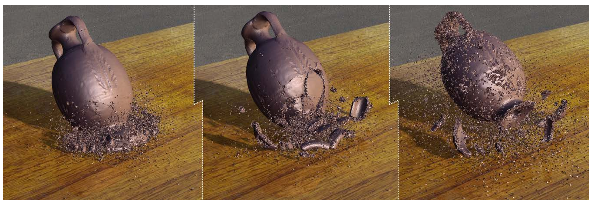SCI-Solver_Peridynamic is a C++/CUDA library written to simulate a fracture behavior in a particle cloud model. It uses GPU hardware to provide a fast solution.
The code was written by Nghia Truong at the Scientific Computing and Imaging Institute,
University of Utah, Salt Lake City, USA.
 Table of Contents
Table of Contents
A Peridynamic Perspective on Spring-Mass Fracture
AUTHORS:
J. A. Levine(1)
A. W. Bargteil(2)
C. Corsi(1)
J. Tessendorf(1)
R. Geist(1)
(1)Clemson University, USA (2)University of Utah, USA
The application of spring-mass systems to the animation of brittle fracture is revisited. The motivation arisesfrom the recent popularity ofperidynamicsin the computational physics community. Peridynamic systems can beregarded as spring-mass systems with two specific properties. First, spring forces are based on a simple strainmetric, thereby decoupling spring stiffness from spring length. Second, masses are connected using a distance-based criterion. The relatively large radius of influence typically leads to a few hundred springs for every masspoint. Spring-mass systems with these properties are shown to be simple to implement, trivially parallelized, andwell-suited to animating brittle fracture.
Requirements
- Git and the standard system build environment tools.
- You will need a CUDA Compatible Graphics card. See here You will also need to be sure your card has CUDA compute capability of at least 2.0.
- SCI-Solver_Peridynamic is compatible with the latest CUDA toolkit (7.5). Download here.
- This project has been tested on Ubuntu 14.04 on NVidia GeForce GTX 560 Ti, and OSX 10.11 on NVidia GeForce GTX 780M.
- If you have a CUDA graphics card equal to or greater than our test machines and are experiencing issues, please contact the repository owners.
- OSX: Please be sure to follow setup for CUDA here. There are several compatability requirements for different MAC machines, including using a different version of CUDA (ie. 5.5).
- Simulation visualizer uses QtCreator >= 5.6 to view results (optional).
cd /BunnyBreak/mesh_query0.1 make -j
cd /BunnyBreak make -j
<h3>Windows</h3>
This software has not yet been ported to Windows.
**Note:** For all platforms, you may need to specify your CUDA toolkit location (especially if you have multiple CUDA versions installed):
```c++
cmake -DCUDA_TOOLKIT_ROOT_DIR="~/NVIDIA/CUDA-7.5" ../src
(Assuming this is the location).
Note: If you have compile errors such as undefined reference: atomicAdd, it is likely you need to set your compute capability manually.
The "BunnyBreak" example is run from /BunnyBreak. The params.txt file is used to specify the necessary parameters for the simulation run. Use a text editor to set the following two paths to suit your system:
- obj_file /path/to/repo/PeriCUDA/BunnyBreak/bunny.obj
- saving_path /path/to/repo/PeriCUDA/BunnyBreak/SimData/BunnyBreak
Other parameters in the file can also be modified, including the following (with descriptions):
- adaptive_integration [0|1] (integration using adaptive time step or fixed time step)
- num_pd_particle int (if it is zero, no particle generated, non zero: generated particles to fill a mesh)
- pd_stretch_limit_s0 double (set threshold on bond stretch. Bonds that stretched beyond this threshold will break)
- mesh_translation_[x|y|z] double (translate the mesh in domain)
- steps_per_frame int (save data every <steps_per_frame> time steps)
- final_step int (final time step)
- boundary_[min|max]_[x|y|z] int (simulation domain)
- pd_kernel_coeff double (define the radius of particle connection, for example, pd_kernel_coeff=5 means that a particle will connect to other particles that stay within 5 times particle radius)
- pd_particle_mass double (mass of particle)
To run the simulation, type:
cd <PATH>/BunnyBreak
./BunnyBreak params.txtTo visualize the results, start QtCreator, open the project file /PeriCUDAViz/PeriCUDAViz.pro & browse to the DATA/ sub-directory of the saving_path specified in the params.txt file.
The BunnyBreak project provides a basic usage example. The project is built by including the static library SPHPEngine.a, and the main.cpp and scene.cpp files. In main.cpp, instances of the Scene and Simulator objects are instantiated, the parameters are set according to the information specified in params.txt, and the simulator is run.
Original Author's Note: This project has been discontinued in favor of CPU simulations that handle much larger models. SPH simulation has been implemented but not completed, so it may work incorrectly.